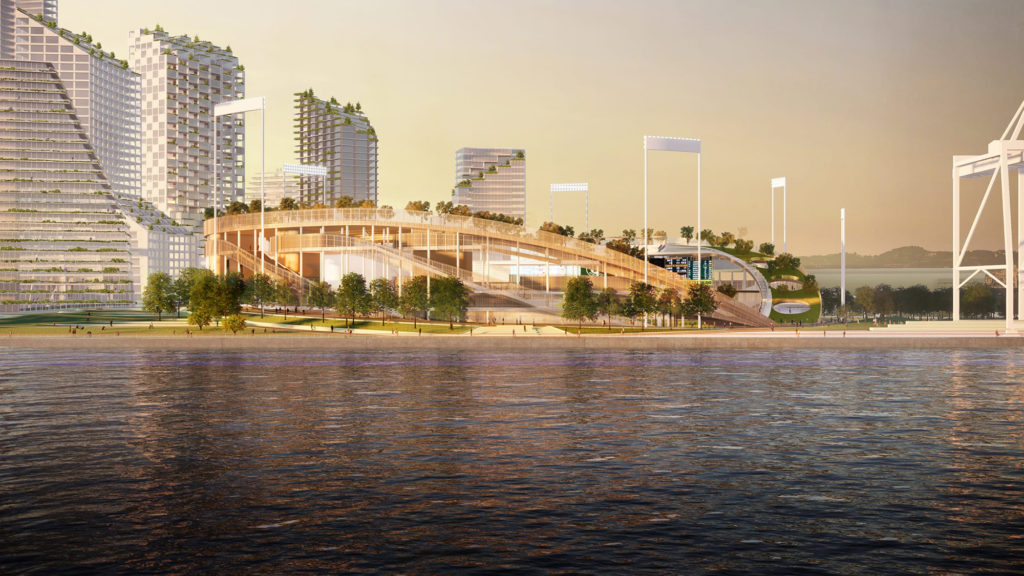
Two more lawsuits are challenging the waterfront location for a new Oakland A’s ballpark, arguing a 3,500-page Environment Impact Report (EIR) did not adequately address concerns about the project.
The legal strategy is the same as presented by a coalition of shipping interests in their lawsuit filed earlier this week challenging the Howard Terminal waterfront location: that the city of Oakland did not follow state guidelines to identify and mitigate all potential adverse effects of the $12-billion Howard Terminal development, one of the largest non-transit developments in state history.
Filing suits: Union Pacific Railroad and the Capitol Corridor Joint Powers Authority, both on the grounds that the EIR minimizes the impact on rail lines near the project. Union Pacific Railroad runs two lines near the proposed development both for freight service and Amtrak service, while Capitol Corridor runs between 22 and 30 passenger trains on those same lines. In addition, Union Pacific Railroad anticipates the need for additional service in the future along a third track. Because the EIR studied only the two pedestrian crossings close to the project, as opposed to all eight crossings in the area.
The A’s have proposed a downtown Howard Terminal waterfront development featuring $12 billion in private investment, including a billion dollars for a new 35,000-capacity ballpark to replace the Oakland-Alameda County Coliseum as the team’s home. The development would also include 3,000 units of housing, as well as 1.5 million square feet of office space, 270,000 square feet of retail space, a 400-room hotel, 18 acres of parkland and an estimated $450 million in community benefits. It would represent a massive makeover of the Oakland waterfront, transforming a industrial site into a mixed-use development.
The groups filing the lawsuit have consistently opposed the project, arguing the waterfront makeover is inappropriate for a shipping port and that the Oakland-Alameda County Coliseum site is more appropriate for a new ballpark. The team’s counterargument is that the planned site is a disused storage area, not an essential part of a working port. Of course, this being California, the lawsuits were anticipated: there’s no such thing as a large development in the state that’s not challenged by multiple lawsuits. How much impact the filing has will be known fairly quickly, however, as state law requires that such lawsuits be resolved within 270 days. There is also plenty of other site work to be tackled as well in the rest of 2022, as the A’s development team will need to prepare mitigation plans for the likes of the San Francisco Bay Conservation and Development Commission and Department of Toxic Substances Control as well as work out details on affordable housing and community benefits for the project.
Rendering courtesy Oakland Athletics.
RELATED STORIES: Lawsuit challenges new Oakland ballpark; Oakland council member raises potential referendum on $12B A’s ballpark project; Advisory board recommends against A’s ballpark at Howard Terminal site; As new Oakland ballpark plan moves forward, Las Vegas becomes long-shot bet; Oakland City Council OKs new ballpark EIR; Oakland Planning Commission approves A’s ballpark EIR; A’s reportedly looking at Tropicana for Vegas ballpark site; A’s succeed in launching bidding war in Las Vegas; A’s ask for feedback on Las Vegas Strip ballpark; Alameda County approves Oakland waterfront ballpark plan; Oakland urges Alameda County support of new ballpark tax district; Alameda County to discuss Athletics ballpark Oct. 26; A’s to narrow field of Vegas sites after playoffs; three sites cited by locals; Alameda County to A’s: Slow down, cowboy; A’s brass resumes Vegas runs, continues talks with Oakland; Oakland, A’s to resume ballpark talks; State funding on tap for new Oakland ballpark?; A’s: Maybe we can work with Oakland on new ballpark terms; Oakland presents term sheet for new ballpark; A’s immediately reject it
